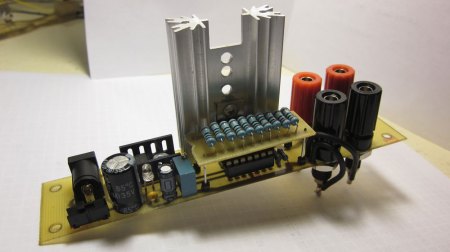 Inspired by a design he saw on the EEVblog, [George Graves] put together this constant current dummy load. You might need on of these if you’re testing power supplies or batteries. They pull a constant current regardless of the voltage of the supply. [George’s] version extends the range of the original a little bit by running the op-amp at 8 volts. He says that everything runs fine at 1 amp. He tried 2 amps but things got hot pretty quickly. What we really like though, is he took fantastic pictures. Sometimes even simple things can catch our attention with the right pictures!
Inspired by a design he saw on the EEVblog, [George Graves] put together this constant current dummy load. You might need on of these if you’re testing power supplies or batteries. They pull a constant current regardless of the voltage of the supply. [George’s] version extends the range of the original a little bit by running the op-amp at 8 volts. He says that everything runs fine at 1 amp. He tried 2 amps but things got hot pretty quickly. What we really like though, is he took fantastic pictures. Sometimes even simple things can catch our attention with the right pictures!
Day: May 15, 2012
Universal 20 Channel Project Controller From A Ps2 Controller

So you’ve got a really cool project that requires a wireless controller and a ton of different channels. What are you going to do? Are you going to go pick up an expensive RC controller? Nah, you’re going to build your own. This project makes a generic 20 channel controller for your projects by stuffing an SMDuino and an XBee module inside a ps2 controller. Unfortunately you lose the force feedback since you have to remove the motors to make space for the extra components and batteries. You do end up with a decently ergonomic and aesthetically pleasing controller though.
Continue reading “Universal 20 Channel Project Controller From A Ps2 Controller”
Controlling Robots With A TRS-80

[DJ Sures], mastermind behind the EZ-B Bluetooth Robot controller, sent in a really interesting build where he controls a robot with a 1983 TRS-80 computer.
The robot in question is [DJ Sures]’ adorable WALL-E we’ve seen before. WALL-E is controlled through a Bluetooth connection to a desktop PC with the EZ-Builder hardware and software package.
To get the Trash-80 talking to WALL-E, [Sures] connected a tiny Bluetooth module to the TX pin of the 6402 UART. It’s a very, very simple modification that adds a Bluetooth serial connection to one of the first notebook computers. After syncing the TRS-80 and WALL-E to the computer running EZ-Builder, it’s a piece of cake to make the robot respond to the clanging of a 30-year-old keyboard.
There’s a video of [DJ Sures] going over his build after the break with a wonderful demo of WALL-E freaking out to a little dubstep. Check that out after the break.
Floating Sensor Networks

These cool looking little bots are part of a fleet of floating water sensors built by The Lagrangian Sensor Systems Laboratory (LSSL) at UC Berkeley, the Lawrence Berkeley National Laboratories (LBNL) and the California Department of Water Resources.
In an emergency such as a levee break, flood, or spill, they can be deployed to gather information in a way that is completely impossible with stationary sensors. These 17″ tall bots can steer with the help of their twin props and communicate water quality information back to the base via cellular communication and short wave radio. They describe the resulting data as being like a “google traffic map” showing speed, depth, and contamination of the water.
There’s a ton of detail on their site, including breakdowns of how the software and hardware are put together. There’s even a bit of the evolution of the hardware showing the abandoned previous models.
Building A 4-bit TTL Computer

When [GG] was 12 years old, he was introduced to BugBooks, the wonderful ‘introduction to digital design’ books from the early 1970s. It has always been a dream of [GG] to build the TTL computer featured in the BugBooks, and now that he has the necessary time and money available to him, the Apollo181 has become a reality.
[GG]’s computer is built around a 74181 ALU, an exceptionally old-school chip that provides the core of a computer in a neat 24-pin chip. With a 256-byte RAM and a few additional logic chips, [GG]’s computer is an exceptional piece of engineering able to perform 625,000 instructions per second when clocked at 2.5 MHz.
This isn’t [GG]’s first homebrew computer build; last year we saw his incredible Z80 minicomputer. Now we can’t wait to see what’s on tap for next year. After the break, you can check out [GG] loading in operands and operators into his computer and letting the Apollo181 churn away on its program.
Building A Sound Reactive EL Panel And Learning Something In The Process

We’ve seen a lot of builds using electroluminescent wire, usually in the realm of costumes and props. Unfortunately, most electrical engineers don’t deal with blinking and dimming EL wire and panels and any tinkerer trying to control electroluminescence doesn’t have a lot of resources on how to control EL stuff. [ch00f] wanted to fill this knowledge gap, so he build a sound reactive EL panel driver and learned a lot in the process.
Nobody really knows how electroluminescent wire and panels work on a molecular level, but [ch00f] did know that changing the direction of an electric field will cause the EL material to glow. Changing the frequency of this electric field will change the EL material’s brightness, so all [ch00f] had to do was make a variable-frequency EL driver – something that’s a lot harder than it sounds.
We won’t bore you with the details because we couldn’t do [ch00f]’s write up any justice. We will skip to the end and tell you [ch00f] was able to make a sound reactive EL panel after a month of work that included making his own transformers and doing a whole bunch of math. You can check out the video of [ch00f]’s [Tony Stark]-esque EL panel after the break.
Continue reading “Building A Sound Reactive EL Panel And Learning Something In The Process”
[Engineerguy] Explains How A CCD Works
[Bill] is back with another fantastic video explaining a piece of intriguing hardware. This time, he’s explaining how a CCD works. For many of us, these things are part of our daily life, but aside from the fact that they capture an image, we don’t put much thought into them. [Bill] breaks things down in a way that we really enjoy. Fast paced and detailed, yet simple enough for even non-engineers to follow. This time, however, he’s also promoting his companion book which includes tons more information, not only on the construction and function of these ideas, but the underlying scientific principles.
The book, called Eight Amazing Engineering Stories, covers the following items:
- Digital camera imagers
- tiny accelerometers
- atomic clocks
- enriched uranium
- batteries
- microwave ovens
- lasers
- anodized metals
We’re excited about the book and it looks like they’ve worked really hard to deliver a quality product. Great job guys.











